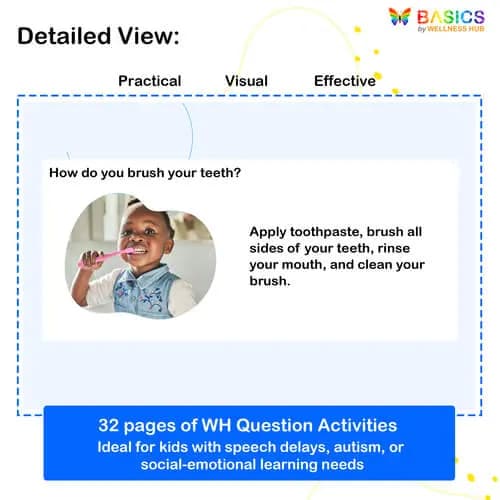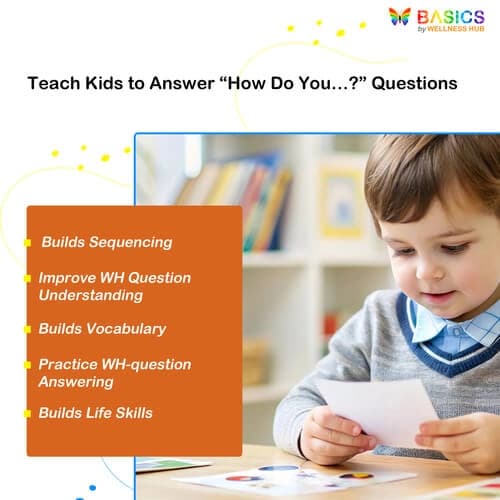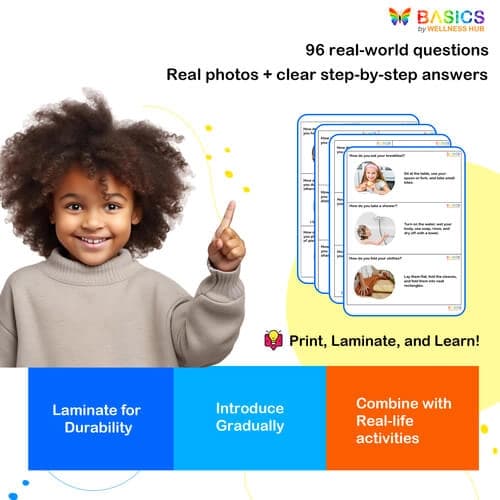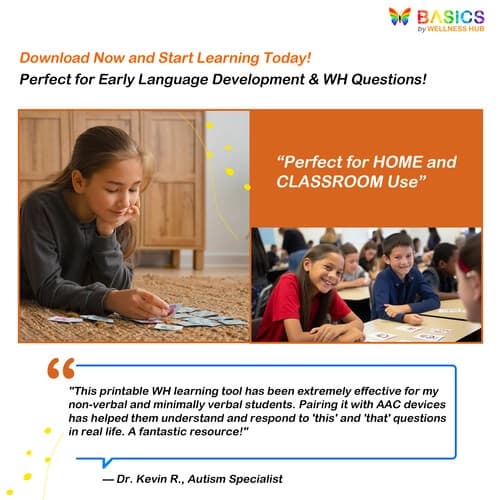

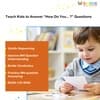
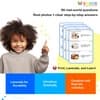
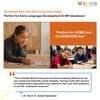
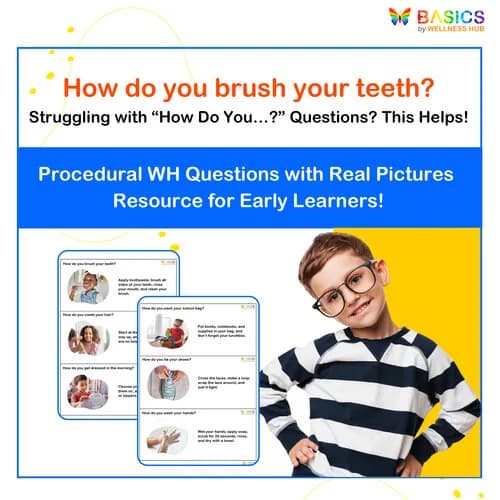
How Do You…? Procedural WH Questions with Real Pictures (Printable PDF)
₹80
₹160
50% off
0 (0 ratings)
Grade Levels
Pre-K - Grade 2 (Ages 4-8)
Content Overview
Format: Printable PDF, Total Pages: 32, Features: 3 procedural “How” questions per page with real images and step-by-step answers
Categories
Pages from the Resource
This printable PDF includes 96 procedural WH questions that teach kids how to describe everyday tasks, routines, and games using clear step-by-step answers. Each question is paired with real-life photos to support visual learning and expressive language development. Ideal for speech therapy, ESL, special education, and early classrooms.
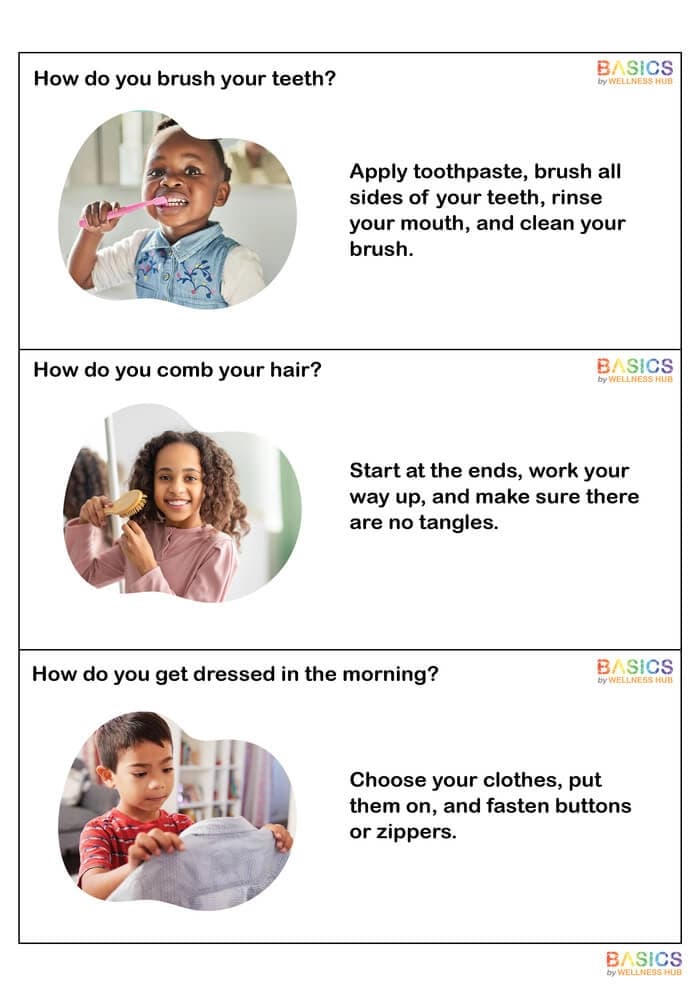
Page 1
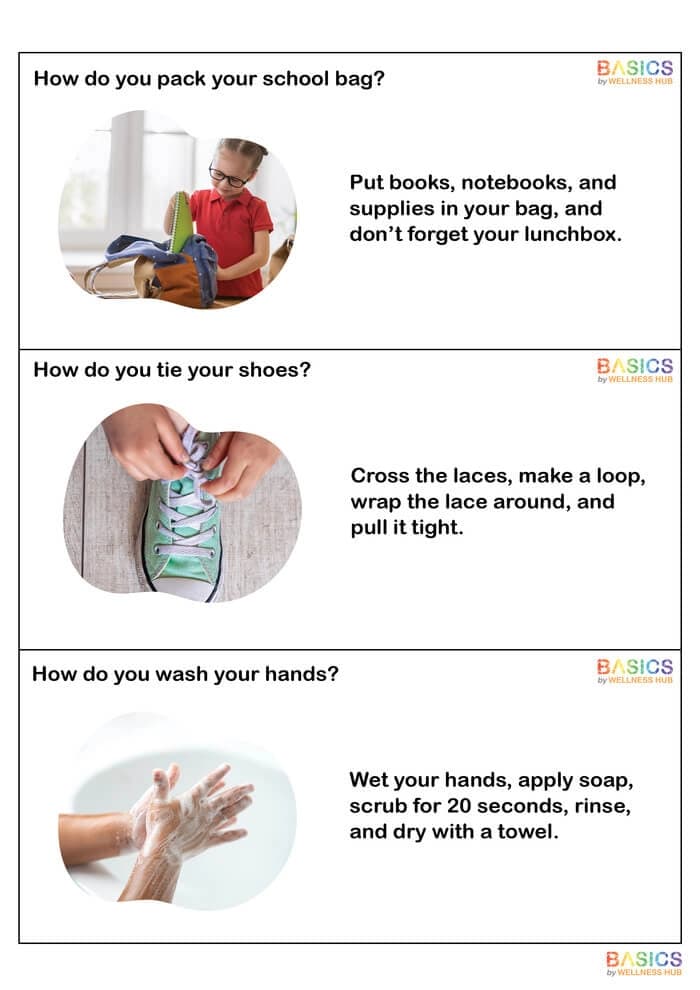
Page 2
What Users Say
0
0 ratings
5
0+
4
0+
3
0+
2
0+
1
0+
5 Stars
Product is Good to use.
1 year ago
Varsha Parent
Similar Products
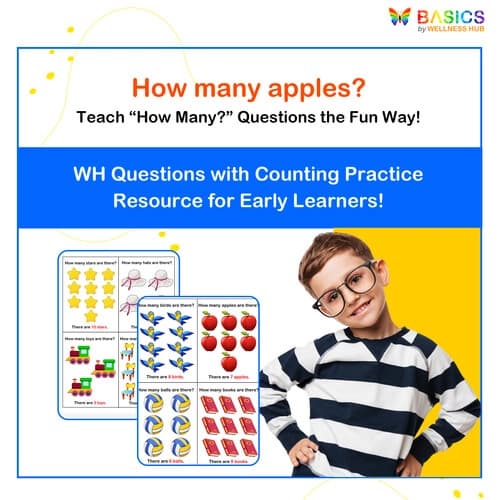
How Many? WH Questions with Counting Practice (Printable PDF)
₹ 80.00
₹ 160.00
50% off
4.6 (46 ratings)
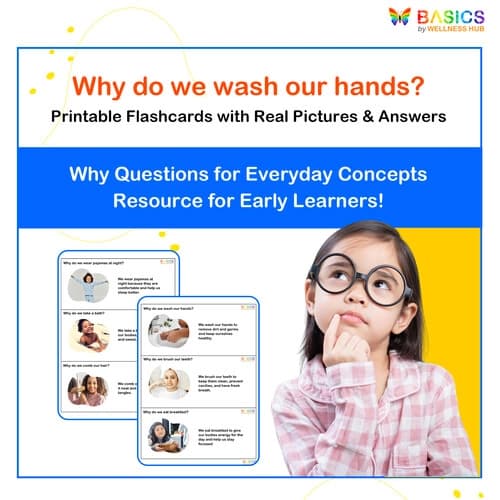
Why Do We…? WH Questions for Everyday Concepts (Printable PDF)
₹ 80.00
₹ 160.00
50% off
5.0 (54 ratings)
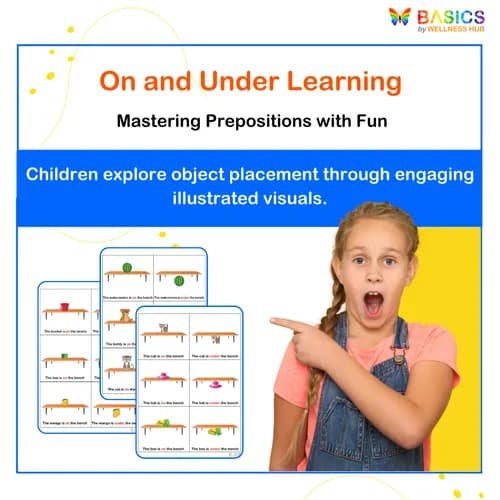
ON & UNDER: Basic Object Position – Printable PDF for Kids
₹ 80.00
₹ 160.00
50% off
4.8 (48 ratings)

Professions Flashcards for Kids – Explore Careers Printable PDF
₹ 80.00
₹ 160.00
50% off
4.6 (54 ratings)
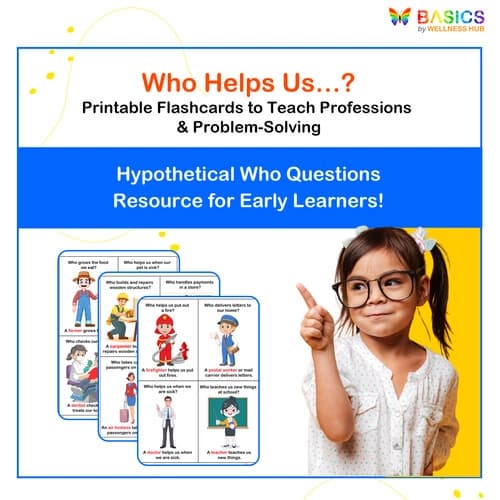
Hypothetical Who Questions – Professions Flashcards for Kids (Printable PDF)
₹ 80.00
₹ 160.00
50% off
4.9 (56 ratings)
About the Product
Introduction
Children are naturally curious about how things work, how daily tasks are done, and how to interact in social and functional settings. But for many early learners, especially those with speech and language delays or special needs, articulating how to perform an action can be challenging.
This resource—“How Do You…?” Procedural WH Questions with Real Pictures—is designed to help children answer procedural “how” questions using clear, structured responses. With 96 questions covering everyday routines, play activities, self-care, and more, the resource guides children to describe sequences of steps in a way that supports both language development and life skill learning.
Whether used in speech therapy, the classroom, or at home, this printable offers high-quality real-life images and easy-to-understand language to build confidence, clarity, and communication in young learners.
Product Details
- Resource Type: Printable PDF
- Total Pages: 32
- Questions Per Page: 3
- Total Questions: 96 unique procedural “How” questions
- Question Format Example:
- “How do you brush your teeth?”
- “Apply toothpaste, brush all sides of your teeth, rinse your mouth, and clean your brush.”
- Content Types:
- Real-life routines (brushing teeth, getting dressed)
- Play-based actions (playing hide and seek, kicking a ball)
- Basic life skills (tying shoes, washing hands, packing a bag)
- Real-life routines (brushing teeth, getting dressed)
- Visuals: Clear, realistic photographs accompanying each question
- Answer Style: Step-by-step explanation using age-appropriate, simple language
- File Format: Printable PDF (compatible with both A4 and US Letter)
- Use Settings: Speech therapy, classroom instruction, homeschooling, ESL, special education, daily life coaching
Educational Benefits
✅ Builds Procedural Language
Children learn how to sequence actions and explain routines using transitional phrases like “First,” “Then,” and “Finally,” which are foundational for academic and conversational skills.
✅ Strengthens WH Question Comprehension
Supports understanding and verbal responses to “How” questions—a more complex and often overlooked WH form that is critical for both receptive and expressive language.
✅ Encourages Functional Communication
The questions are tied to real-life scenarios that children encounter daily. This allows them to generalize language to home and school environments, promoting independence.
✅ Enhances Vocabulary and Grammar
Each answer models correct sentence structure, verbs, and sequencing terms, helping children expand their vocabulary while learning to organize and articulate their thoughts clearly.
✅ Ideal for Diverse Learners
Perfect for:
- Children with speech and language delays
- ESL/ELL learners
- Students with autism or cognitive delays
- Children in inclusive or special education classrooms
✅ Supports Social-Emotional Learning
By exploring how to interact with others through games and routines, the resource also helps develop turn-taking, cooperation, and routine understanding.
Instructions for Use
1️⃣ Print or Open Digitally
- Print the 32 pages as a full workbook or individual sheets.
- Alternatively, open the PDF on a tablet or computer for teletherapy or screen-sharing
- Laminate pages for repeated use or use dry-erase pockets.
2️⃣ Introduce the Concept
- Start with a question like “How do you brush your teeth?”
- Show the corresponding image and ask the child to describe the steps.
- Model the correct answer if needed, then encourage the child to repeat or rephrase it.
3️⃣ Break Down the Answer
- Focus on the sequence of steps using prompts like “What comes first?” or “What do you do after that?”
- Use visual cues to help them recall and organize the process.
4️⃣ Practice Across Contexts
- Use this resource during morning routines, playtime, therapy sessions, or circle time.
- Reinforce learning by acting out the routine, using real objects, or asking the child to explain what they just did in real life.
5️⃣ Scaffold Based on Ability
- For early learners: Provide sentence starters like “First I…” or “Then I…”
- For advanced learners: Ask follow-up questions like “Why is that step important?” or “What happens if you skip a step?”
Activities Using the Resource
These engaging activities turn your “How” question cards into powerful tools for building expressive language, sequencing, and social skills. You can use them in speech therapy, home routines, classrooms, or teletherapy sessions.
1. Ask–Answer–Act
Objective: Develop verbal sequencing and real-life application
How to Use:
- Show a card and ask: “How do you brush your teeth?”
- Have the child read or repeat the answer.
- Act it out using real objects or gestures in the correct sequence.
- Encourage full-sentence responses and time-order words (first, then, next, finally).
2. Draw the Steps
Objective: Reinforce understanding of multi-step processes through visual expression
How to Use:
- Ask the child to draw 3–4 simple steps of a routine they just discussed.
- Label the steps together using phrases from the modeled answer.
- Great for classrooms, home practice, or occupational therapy crossover.
3. Role-Play Routines
Objective: Practice social and functional communication
How to Use:
- Choose a card like “How do you play hide and seek?”
- Take turns acting out the routine while narrating each step aloud.
- Use this with other children or parents to reinforce cooperative play and storytelling.
4. Sort by Theme or Setting
Objective: Build categorization and flexible thinking
How to Use:
- Mix cards and ask children to sort them into categories such as:
- “At home” vs. “At school”
- “Self-care” vs. “Playtime”
- “Morning” vs. “Evening” routines
- “At home” vs. “At school”
- Follow up with “How do you…?” prompts from each sorted group.
5. Reorder the Steps
Objective: Strengthen sequencing and reasoning
How to Use:
- Read a full answer out of order and have the child correct the sequence.
- For example: “First you rinse your mouth, then you apply toothpaste…”
- Ask, “Does that sound right? What should come first?”
FAQs
Q1: What age group is this resource best for?
A1: This resource is designed for children aged 4–8 (Pre-K through Grade 2), but it’s also effective for older learners with special needs who are developing procedural language and life skills.
Q2: Is it suitable for children with autism or speech delays?
A2: Yes! The real images, step-by-step answers, and repetitive structure make it ideal for children with autism spectrum disorder, apraxia, ADHD, or language processing difficulties.
Q3: Can I use this in a general education classroom?
A3: Absolutely. It’s a fantastic tool for teaching routine sequencing, vocabulary, and verbal expression, even for typically developing learners or ESL students.
Q4: Is it appropriate for ESL/ELL students?
A4: Yes. The visuals and consistent structure make this an excellent ESL resource for teaching functional language, verbs, and sentence formation in a clear and supportive way.
Q5: Can this be used during virtual sessions?
A5: Definitely. You can display the PDF using screen share in teletherapy or online classes, and still have children answer verbally, act out routines, or draw steps on their end.
Q6: Does it include only hygiene routines?
A6: No, the resource includes a wide variety of content:
- Self-care routines (e.g., brushing teeth, getting dressed)
- Social play (e.g., playing games)
- Classroom behaviors
- Life skills (e.g., packing a bag, setting the table)
Usage Rights and Restrictions
You May:
- Use this printable in 1:1 sessions, group therapy, classrooms, or home learning
- Display pages during virtual instruction or screen-sharing
- Print unlimited copies for personal or single-classroom use
- Share the product link with parents or professionals
You May Not:
- Post the PDF online or on file-sharing platforms
- Sell, distribute, or modify the resource for resale
- Use it in digital courses or commercial products without permission
- Share beyond your own students or caseload without additional licensing
Need a multi-classroom, clinic-wide, or school license? Contact us for extended usage options.
Conclusion
“How Do You…?” Procedural WH Questions with Real Pictures is a research-backed, easy-to-use resource that helps children confidently respond to everyday “how” questions using full sentences and structured thinking. Whether your goal is to improve sequencing, vocabulary, independence, or social communication, this pack delivers with visual clarity and developmental intent.
It’s the perfect tool for:
✔️ Speech therapists
✔️ Special educators
✔️ ESL teachers
✔️ Parents and caregivers
✔️ Early childhood instructors
Download now and start helping your child or student describe, do, and grow—step by step!
